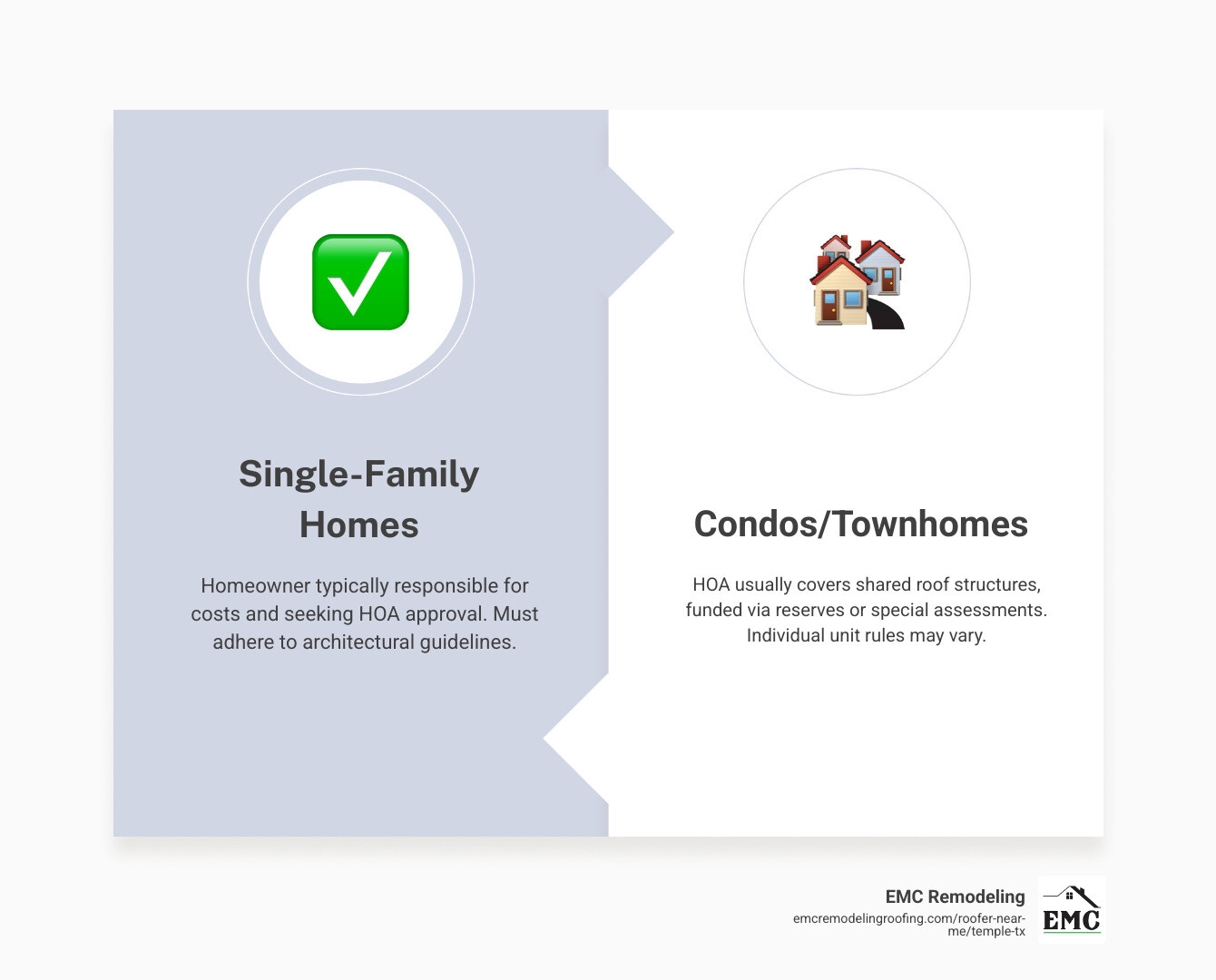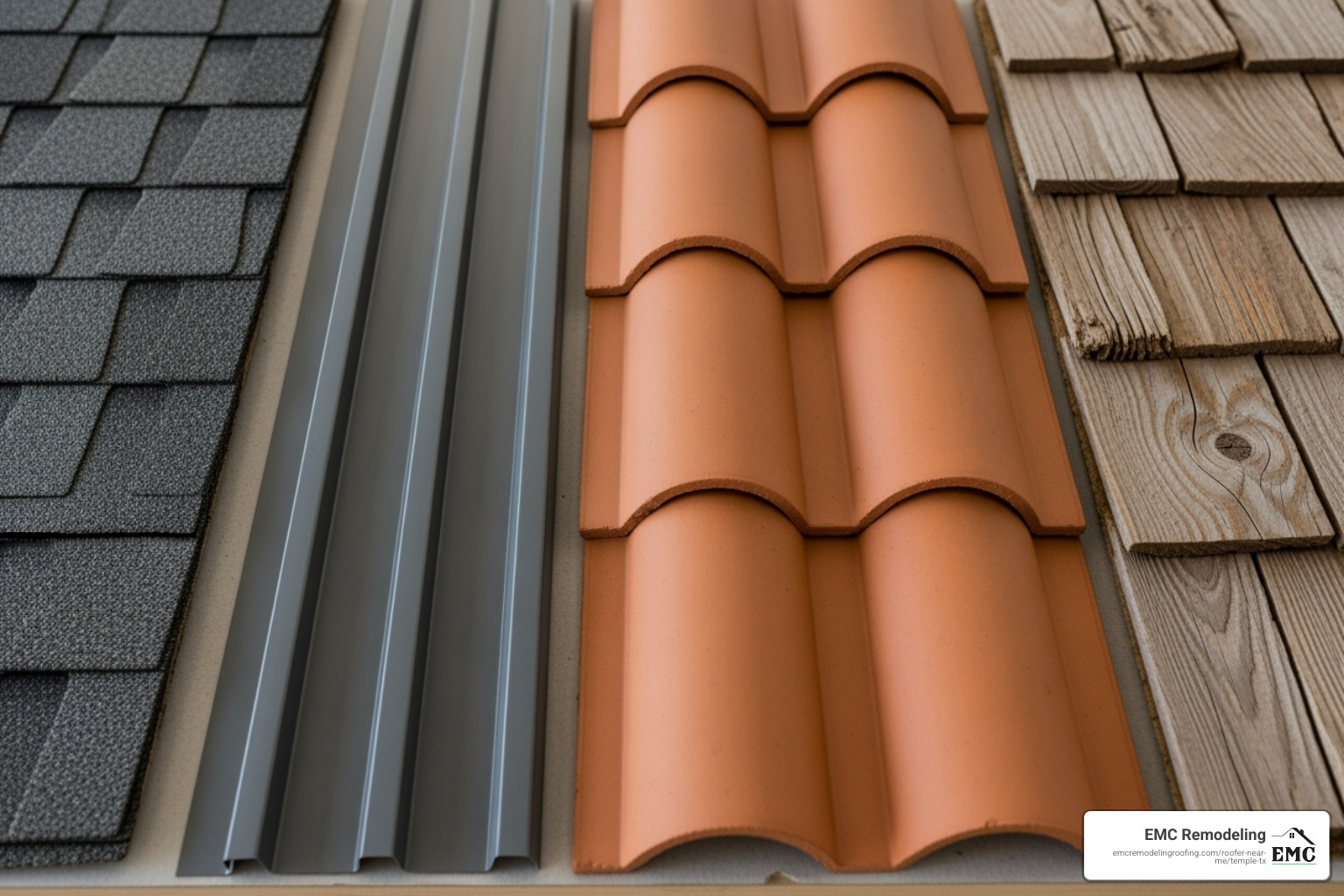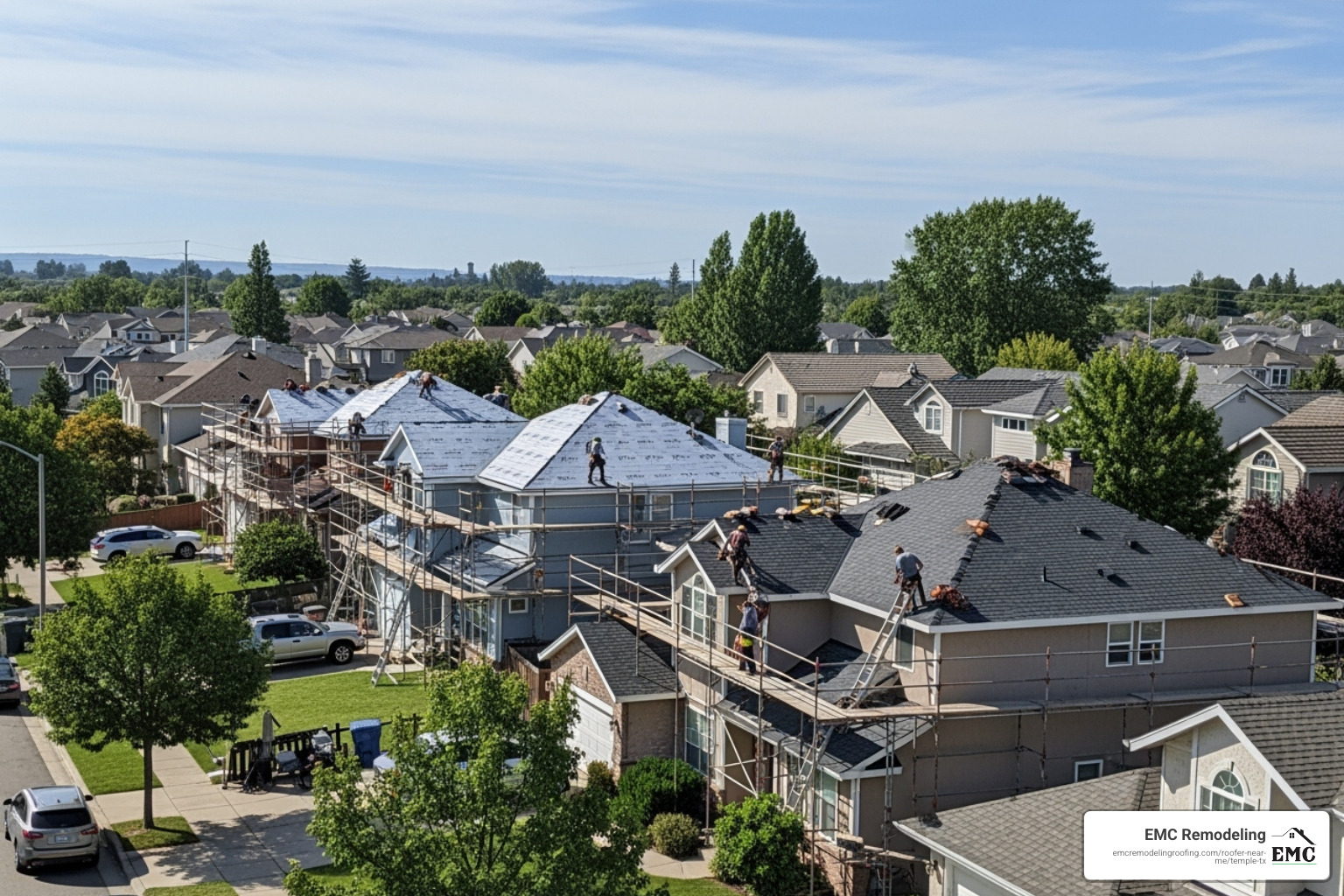Before You Call a Roofer: Why Your HOA’s Rules Come First
Living in a homeowners association offers many benefits, but when it comes to major projects, navigating the rules for an HOA roof replacement can feel overwhelming. Responsibility depends on your property type and governing documents. Here’s a quick overview:
For Single-Family Homes:
- The homeowner is typically responsible for all costs.
- You must follow HOA architectural guidelines.
- Pre-approval is required before starting work.
For Condos/Townhomes:
- The HOA usually covers shared roof structures.
- Funding comes from reserves or special assessments.
- Rules for individual units may vary.
Key Steps:
- Review your CC&Rs for maintenance clauses.
- Submit an application to the Architectural Review Committee.
- Wait for approval (typically 30 days).
- Use only HOA-approved materials and contractors.
With nearly 70% of HOAs having insufficient reserve funds for major expenses, confusion over payment is common. Some homeowners face unexpected $15,000 roof replacements, while others learn their HOA will cover it through a special assessment. The difference lies in your governing documents and property type. Getting it wrong can lead to fines, forced re-work, or legal action. Understanding your HOA’s rules before you start is the key to a smooth project.

Who Holds the Hammer? Defining Roof Responsibility in Your HOA
The first question every HOA homeowner asks when their roof fails is: “Who pays for this?” The answer lies within your HOA’s governing documents.

Your Covenants, Conditions, and Restrictions (CC&Rs) and bylaws define maintenance responsibilities. They distinguish between “common elements” (like a community pool, owned by all) and “limited common elements” (areas designated for specific homeowners, like a patio or sometimes a roof section). Understanding these terms is crucial, as it determines whether you pay for a new roof yourself or split the cost with neighbors.
Single-Family Homes vs. Condos/Townhomes
Your property type is the biggest factor in determining hoa roof replacement responsibility.
Single-Family Homes: You typically own the house and the land, making you responsible for the entire roof replacement cost. While you foot the bill, the HOA’s architectural guidelines will still dictate the materials and colors you can use to maintain the neighborhood’s aesthetic.
Condos and Townhomes: In most multi-unit buildings, the roof is a “common element.” The HOA manages and pays for its replacement using reserve funds or a special assessment. Instead of a $15,000 bill, your share might be a few hundred dollars. However, some townhome roofs are classified as “limited common elements,” which can create shared responsibility, so always verify with your specific documents.
Key Clauses to Review in Your HOA Documents
Before planning a replacement, review your CC&Rs for these sections to avoid costly mistakes:
- Maintenance and Repair: Look for specific language about “roofs,” “structural components,” and “exterior surfaces.” Does the HOA cover all exteriors or only common area roofs?
- Architectural Guidelines: This section outlines approved materials, colors, and styles. Even if you pay for the roof, you must adhere to these rules.
- Insurance Requirements: This clarifies if the HOA’s master policy covers roof damage to individual units or just common areas, helping you identify gaps in your personal coverage.
- Definitions: Pay close attention to terms like “Common Area,” “Limited Common Element,” and “Aesthetic Uniformity.” These definitions are the foundation of who pays for what.
The HOA Approval Gauntlet: A Step-by-Step Process
Once you’ve confirmed your responsibility, you must get your HOA’s official blessing. Skipping this step can lead to significant penalties.

The process begins with a formal application to your Architectural Review Committee (ARC). Your proposal should include project plans, material and color samples, your contractor’s information, and a proposed timeline. You’ll also need supporting documents like building permits and your contractor’s certificate of insurance, which protects you and the HOA from liability.
After submission, the waiting period begins. Most HOAs have 30 days to respond. Plan ahead, as some boards only meet monthly. If your request is denied, understand the concerns, make adjustments, and resubmit.
Common Reasons an HOA Requires a Roof Replacement
HOAs mandate roof replacements to protect the community’s investment, not just to be picky. Common reasons include:
- Aesthetic Uniformity: A faded, discolored, or poorly patched roof can bring down the look of the entire neighborhood.
- Age: Most roofs last 20-30 years. HOAs may require replacement as a roof nears the end of its lifespan to prevent future issues.
- Visible Damage: Curling or missing shingles are signs of failure that can lead to structural damage.
- Property Values: Well-maintained, uniform roofs contribute to higher home prices for everyone.
- Community-Wide Projects: In condos or townhomes, large-scale projects ensure consistency and can leverage bulk pricing.
The Perils of Unapproved Work
Performing an hoa roof replacement without permission is a costly mistake. The consequences can include:
- Fines: Daily or monthly penalties can add up quickly, sometimes $50-$100 per day.
- Forced Removal: The HOA can legally require you to tear off the unapproved roof and replace it again with compliant materials, forcing you to pay for the job twice.
- Legal Action: Refusing to comply can lead to lawsuits, attorney fees, and court costs.
- Property Liens: HOAs can place a lien on your property for unpaid fines, making it difficult to sell or refinance.
Always get approval before starting work. A few weeks of planning can save you thousands of dollars and major stress.
The Financial Blueprint: Funding Your HOA Roof Replacement
How much will an hoa roof replacement cost? The answer isn’t always simple, especially since nearly 70% of HOAs have underfunded reserves, which can lead to unexpected costs for homeowners.

A typical asphalt shingle roof replacement costs $3.50 to $5.50 per square foot, meaning a 2,000 sq. ft. roof can run from $7,000 to $11,000. When the HOA is responsible (usually in condos/townhomes), they use reserve funds collected from monthly dues. If these funds are insufficient, the HOA will issue a special assessment—a one-time bill shared among homeowners, which can range from $3,000 to over $15,000 per unit.
Insurance: The HOA’s Master Policy vs. Your Own
Understanding insurance involves two policies that can overlap or leave coverage gaps.
- HOA Master Policy: This covers the building structure and common areas. For condos, this usually includes the roof. It’s a “peril-based” policy, covering damage from specific events like storms or fire.
- Personal Homeowner’s Policy: For condo owners, an HO-6 policy covers your unit’s interior and personal belongings. For single-family homes, your personal policy is almost always responsible for roof damage from covered events.
How Roof Age and Condition Impact Coverage
Your roof’s age is a critical factor in what insurance will cover.
- Scheduled Replacement: A roof that fails due to old age (typically 20-30 years) is considered maintenance. Neither your personal nor the HOA’s master policy will cover replacement due to normal wear and tear.
- Sudden Damage: Storm damage is typically covered, but the payout may be affected by the roof’s age. Older roofs might only receive “actual cash value,” which accounts for depreciation and won’t cover the full replacement cost.
Documenting your roof’s condition with regular inspections helps clarify whether failure is due to age or a covered event, providing a clear baseline for any claims.
From Shingles to Sign-Off: Choosing Compliant Materials and Contractors

HOA roof replacement projects have strict material restrictions to maintain community aesthetics. Your architectural guidelines will specify approved materials (like asphalt, metal, or tile), styles, and colors. Most HOAs prefer durable architectural shingles (30-year lifespan) over less durable 3-tab shingles (20-25 year lifespan). Expect a limited color palette of neutral tones. Some HOAs may even require specific brands or mandate certain contractors to ensure quality and uniformity.
Choosing a Contractor Who Understands HOA Rules
For an HOA project, you need a contractor who understands the specific rules and documentation requirements. An experienced professional will know how to prepare a proposal that satisfies the review committee and can communicate effectively with your HOA board.
Look for local companies with a strong track record in your area. They will be familiar with local building codes and the nuances of area HOAs. As expert roofers in Temple, TX, EMC Remodeling has helped many Central Texas homeowners steer these challenges in communities throughout Temple, Belton, and Killeen.
EMC Remodeling
5100 Midway Dr Suite 211, Temple, TX 76502
(254) 760-9268
When vetting contractors, verify their licensing and insurance, and ask for references from other HOA projects. A quality contractor will be transparent and can help with permits and insurance claims.
What to Do When You Disagree with the HOA
Disagreements can happen. If your request is denied or you face an unfair assessment, you have recourse.
- Review Documents: Double-check your CC&Rs to ensure your position aligns with the written rules.
- Use the Appeal Process: Most HOAs have a formal process for appealing board decisions. Present your case professionally with supporting facts.
- Suggest Mediation: A neutral third party can help resolve disputes without costly legal action.
- Get Multiple Bids: If a cost is disputed, presenting competitive bids from other qualified contractors can support your case.
- Document Everything: Keep a detailed record of all communications (dates, names, topics). Emails are especially useful as a paper trail.
Frequently Asked Questions about HOA Roof Replacements
Concerns about hoa roof replacement often revolve around cost, control, and compliance. Here are answers to the most common questions we hear from homeowners.
Can my HOA force me to use a specific, more expensive roofing material?
Yes, they likely can. The CC&Rs you agreed to when buying your home are legally binding. These architectural standards are in place to maintain aesthetic consistency and protect property values. The requirements must be reasonable and applied uniformly to all homeowners. For example, an HOA can require longer-lasting architectural shingles over standard 3-tab shingles, even if it adds to the cost. This rule ultimately protects your investment by ensuring the entire community is well-maintained.
What happens if a community-wide roof replacement is needed but the HOA is underfunded?
This is a common problem, as nearly 70% of HOAs have insufficient reserves. When funds are short, the HOA must find a way to pay for necessary projects. The most common solutions include:
- Special Assessments: A one-time bill is issued to every homeowner to cover the shortfall. This can range from a few thousand to over $15,000 per unit.
- Phased Projects: The replacement is done in sections over several years as funds become available.
- HOA Loans: The association takes out a loan, which is repaid through a temporary or permanent increase in monthly dues.
The homeowners must fund the project, which is why participating in your HOA’s financial planning is so important.
Do I need HOA approval for a minor roof repair?
It depends on the scope and visibility of the repair. If you are replacing a few shingles with an identical match that won’t be noticeable, you likely don’t need approval. However, if the repair involves a significant area, uses different materials, or is visible from the street or common areas, you almost certainly need to submit an application. Some HOAs have specific rules defining what constitutes a “minor” repair versus a modification. When in doubt, ask. A quick email to your property manager can prevent a violation. For emergency repairs, notify the HOA as soon as possible to explain the situation.
Protect Your Investment: Final Steps for a Compliant Roof Replacement
Navigating an hoa roof replacement doesn’t have to be overwhelming. Success hinges on understanding your community’s specific rules, which are outlined in your governing documents. These CC&Rs detail financial responsibilities, approved materials, and the approval process.
Communication is your most effective tool. Engage with your HOA board early, ask questions, and submit a complete application. Partnering with a contractor who understands both roofing and HOA requirements is also crucial for a smooth project. They can help you steer the approval process and ensure all work is compliant.
HOA rules exist to protect property values and maintain community standards for everyone’s benefit. A high-quality, compliant roof is a vital part of protecting your home, which is likely your largest investment.
At EMC Remodeling, we understand the local building codes, weather challenges, and HOA requirements across Central Texas. For a seamless and compliant Roof Replacement, trust our team to handle the details so you can enjoy your newly protected home.
